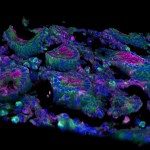Link to Pubmed [PMID] – 18078974
Virology 2008 Mar;373(1):51-60
Similar to the lentiviruses family of retroviruses, foamy viruses (FVs) contain purine-rich sequences located in the center of the genome. Their function on viral replication or vector transfer remains elusive, although dual initiation of plus-strand reverse transcription has been suggested. To elucidate the physical nature of the central region of the prototype FV (PFV) genome, we performed 3′ and 5′ RACE experiments. Our results revealed that the PFV genome contains a centrally located gap in the DNA plus-strand with no definite termination and start point and of variable length. We did not find evidence for a DNA flap region. The PFV isolate harbors four centrally located purine-rich elements (A-D). Only the D element is identical in sequence to the 3′ poly purine tract (PPT). We mutated these elements while conserving or altering the overlapping pol reading frame and analyzed the mutants for transient replication in an infectious or for vector transfer in a replication-deficient background. In addition, we determined the protein composition of the respective viral particles. The A and B elements appeared to play a role in Pol protein encapsidation, the C element is likely involved in regulating gene expression, while mutation of the D element resulted in an insignificant reduction in transiently replicating virus and an approximately 50% reduction in vector titer. The reason for this deficit remains to be elucidated.
